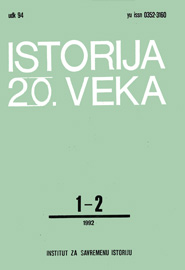UNUTRAŠNJE (ADMINISTRATIVNE) GRANICE JUGOSLAVIJE IZMEĐU DVA SVETSKA RATA 1918 - 1941.
INNER (ADMINISTRATIVE) BORDERS IN YUGOSLAVIA 1918-1941
Author(s): Branislav GligorijevićSubject(s): Geography, Regional studies, Political history, Recent History (1900 till today), Government/Political systems, Pre-WW I & WW I (1900 -1919), Interwar Period (1920 - 1939), WW II and following years (1940 - 1949), Inter-Ethnic Relations
Published by: Institut za savremenu istoriju, Beograd
Keywords: Yugoslavia; 1918; interwar period; administrative borders; states integration; Vidovdan constitution;
Summary/Abstract: Yugoslavia was formed in 1918 by the integration of existing separate states, Serbia and Montenegro and former Austro-Hungarian provinces: Slovenia, Croatia, Dalmatia, Bosnia and Hercegovina and Vojvodina i.e. Banat, Bačka and Baranja. Due to the ethnic conglomeration and historical circumstances, two opposing tendencies prevailed concerning the organization of the state: one, to organize Yugoslavia as a unitary state, the other, that Yugoslavia should become a confederacy. In the first case, care was taken to ignore ethnic borders, and in the second, to create separate national states within these ethnic borders. The 1921 Vidovdan constitution divided Yugoslavia into thirty-three regions whose organs had a certain autonomy, while a law Issued in 1929 and confirmed by the Constitution of 1931 divided the country into nine administrative areas (banovina). In both cases borders were defined according to economic, geographic criteria, ignoring the ethnic factor. Ten years later, in 1939, Banovina Hrvatska was formed as a »corpus separatum« or anasymmetric federation, mainly by ethnic criteria: its borders included, besides Croatia and Dalmatia also parts of Bosnia and Hercegovina and Vojvodina. In 1940 a project was made to form separate »Serbian Lands«. This contribution was based on published and unpublished sources (texts of constitutions, laws) and literature, and is part of a wider topic concerning the borders of Yugoslavia.
Journal: Istorija 20. veka
- Issue Year: 1992
- Issue No: 1+2
- Page Range: 27-34
- Page Count: 8
- Language: Serbian

